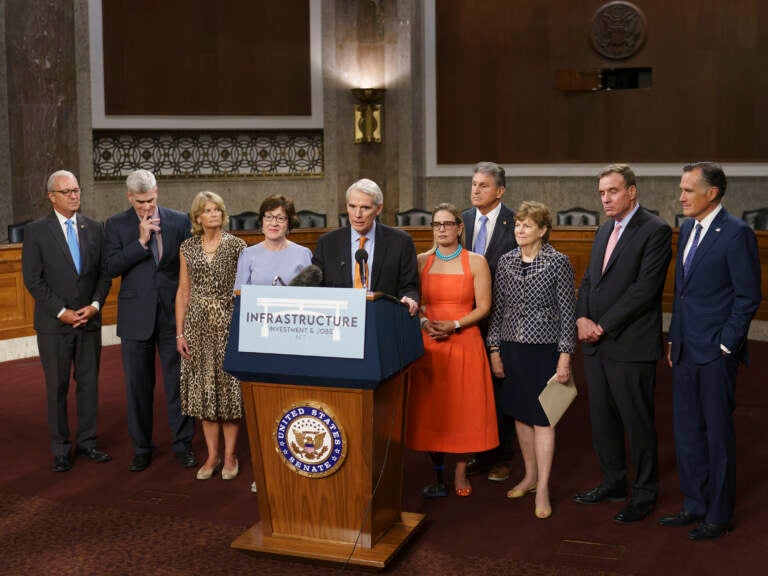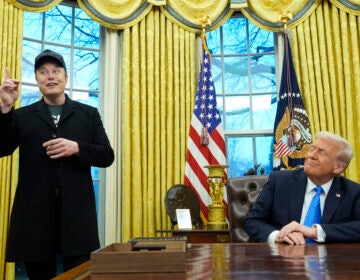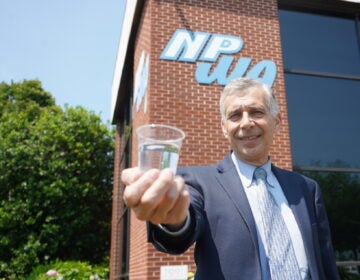The bipartisan infrastructure bill advances in the Senate

The bipartisan group of senators who are behind the infrastructure package talk to the press on July 28. (J. Scott Applewhite/AP)
A roughly $1 trillion bipartisan infrastructure bill cleared a critical hurdle in the Senate Saturday, paving the way for final Senate consideration and looming showdown with progressive Democrats in the House.
The vote was 67-27. It is unclear when a final vote would occur.
“We can get this done the easy way or the hard way,” Senate Majority Leader Chuck Schumer said on the Senate floor ahead of the cloture vote. “In either case, the Senate will stay in session until we finish our work. It’s up to my Republican colleagues how long it takes.”
It was unclear when a final vote on the measure would occur. Senate Republican Leader Mitch McConnell said the “full Senate deserves its full chance to shape this important legislation.”
“I hope Senators can work together in a bipartisan way to get more amendments up and continue improving this important bill,” he said. “Our colleagues on both sides deserve to be heard.”
The legislation includes nearly $550 billion in new spending above what Congress was already planning to allocate for infrastructure over the next eight years. Senate Democrats are expected to move quickly following the vote to begin work on a budget resolution in hopes of passing a broader package of investments that do not have the support of Republicans.
McConnell called that package a showcase for the “full radicalism of the far left.”
The bipartisan legislation faces an uncertain future in the House where a number of progressive Democrats are frustrated with the limited scope of the bill. House Speaker Nancy Pelosi, D-Calif., has said she will not take up the bipartisan bill until the broader budget bill has also passed the Senate.
The Senate infrastructure bill was largely negotiated by a group of five Democrats, led in party by Sens. Kyrsten Sinema of Arizona and Joe Manchin of West Virginia, and five Republicans, led by Sens. Rob Portman of Ohio and Mitt Romney of Utah.
The group worked for weeks to identify a common definition for what infrastructure actually entails and how much the two parties were willing to invest in improvements. The talks dragged out as negotiators worked with White House staff to craft a deal that could win the support of President Biden and at least 10 Senate Republicans.
Lawmakers set aside the largest share of the money, $110 billion, for roads and bridges.
The bill also includes roughly:
- $73 billion for electric grid and power infrastructure
- $66 billion for passenger and freight rail
- $65 billion for broadband investments
- $55 billion for water systems and infrastructure
- $50 billion for Western water storage
- $39 billion for public transit
- $25 billion for airports
- $21 billion for environmental remediation projects
- $17 billion for ports and waterways
- $15 billion for electric vehicles
- $11 billion for road safety
The Senate is expected to move quickly to begin the process of voting on a budget resolution that could allow Democrats to approve as much as $3.5 trillion in additional spending without the support of Republicans.
Democrats plan to use the budget reconciliation process to avoid a filibuster on the remainder of Biden’s broader infrastructure plan. That includes investments in free community college, child care, paid family leave and efforts to slow and mitigate climate change.
Democrats are expected to fine-tune their plans for reconciliation over the next several months in hopes of passing a final bill by the end of this year.
9(MDAzMzI1ODY3MDEyMzkzOTE3NjIxNDg3MQ001))




